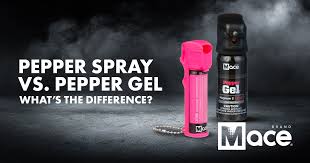In today’s world, personal safety and self-defense have become crucial concerns for individuals. When it comes to protecting oneself, pepper spray and pepper gel are two popular options that are often considered.
Both these products are designed to provide temporary incapacitation, buying valuable time to escape or seek assistance.
In this article, we will compare and explore the differences between pepper spray and pepper gel, helping you make an informed decision based on your specific needs.
What is Pepper Spray?
Pepper spray, also known as OC spray (oleoresin capsicum), is a non-lethal self-defense tool commonly used by individuals for personal protection.
It is composed of a combination of chili peppers, typically cayenne or habanero, which contain a substance called capsaicin. When sprayed, capsaicin irritates the eyes, nose, throat, and skin, causing temporary discomfort and impaired vision.
Pepper spray’s effectiveness lies in capsaicin’s ability to inflame the mucous membranes, resulting in intense burning sensations, temporary blindness, and difficulty breathing.
This can incapacitate an attacker, providing an opportunity for the victim to escape or seek help. Pepper spray usually comes in small canisters that can be easily carried in a pocket or purse.
What is Pepper Gel?
Pepper gel is a relatively new innovation in the field of self-defense. It shares similarities with pepper spray in terms of composition but differs in its delivery mechanism. Pepper gel contains the same capsaicin substance found in pepper spray, but it is suspended in a sticky gel form instead of a liquid.
When sprayed, the gel adheres to the assailant’s face, creating a sticky and immobilizing barrier. Unlike traditional pepper spray, pepper gel is less likely to be affected by wind conditions and has a longer range. Moreover, the gel formula reduces the risk of cross-contamination, as it is less likely to disperse into the surrounding area.
Comparison: Pepper Spray vs. Pepper Gel
To determine which option is better for self-defense, let’s compare pepper spray and pepper gel based on various factors.
Delivery Mechanisms and Coverage
Pepper spray is typically dispersed in a cone-shaped pattern, providing wider coverage. This can be beneficial when dealing with multiple attackers or when a broader defensive perimeter is required. However, it is important to note that the cone-shaped spray may also have a higher chance of affecting innocent bystanders.
On the other hand, pepper gel offers a more targeted and accurate delivery. The gel adheres to the attacker’s face, minimizing the risk of unintentional exposure to others. This accuracy can be particularly advantageous in situations where precision is crucial, such as indoors or crowded areas.
Range and Effectiveness
In terms of range, pepper gel generally outperforms pepper spray. Pepper gel can reach targets at a greater distance, making it a more reliable option, especially in outdoor environments. The gel’s sticky nature ensures better target control, as it adheres to the assailant’s face rather than dissipating in the air like pepper spray.
Both pepper spray and pepper gel are effective in incapacitating an attacker temporarily. The intense burning sensations and impaired vision caused by capsaicin can significantly disrupt an assailant’s ability to continue an attack.
Accuracy and Control
Pepper gel offers better accuracy and control compared to pepper spray. The gel’s sticky formula helps prevent blowback, which can occur with pepper spray, minimizing the risk of self-exposure or accidental contact with others. This feature makes pepper gel an appealing choice for individuals concerned about using the product in crowded or confined spaces.
Wind Resistance and Other Considerations
Wind resistance is an important factor to consider when choosing between pepper spray and pepper gel. Pepper gel is less affected by wind conditions due to its gel-based composition. This makes it more reliable in outdoor situations where wind might disperse the spray of pepper spray.
It is also important to consider other factors such as ease of use, portability, and the potential legal restrictions and regulations in your jurisdiction. Researching and understanding the laws regarding the possession and use of self-defense tools is essential before making a decision.
Choosing the Right Option
When deciding between pepper spray and pepper gel, several factors should be considered:
- Personal preferences and comfort level: Choose the option that you feel most confident and comfortable handling.
- Legal restrictions and regulations: Familiarize yourself with the laws regarding the possession and use of self-defense tools in your area.
- Specific scenarios: Consider the environment and situations in which you are most likely to use the product, such as indoor or outdoor settings.
Safety and Proper Use
Regardless of whether you choose pepper spray or pepper gel, understanding proper usage instructions is vital. Here are some important safety considerations:
- Familiarize yourself with the features, range, and deployment mechanism of the chosen product.
- Practice using the self-defense tool in a controlled environment to gain confidence and ensure effective deployment.
- Store pepper spray or pepper gel in a secure place away from children and heat sources.
- Regularly check the expiration date and replace the product if necessary.
- Remember that self-defense tools should only be used as a last resort and in situations where you genuinely feel threatened.
Other Self-Defense Options
While pepper spray and pepper gel are effective self-defense options, there are other alternatives worth considering:
- Personal alarms: These devices emit loud sounds to attract attention and deter potential attackers.
- Tasers: Tasers deliver a stronger electrical shock that temporarily immobilizes an assailant. However, it is essential to understand the local laws and regulations regarding the possession and use of such devices.
Conclusion
When it comes to personal safety and self-defense, both pepper spray and pepper gel are valuable tools to consider. Pepper spray provides wider coverage, while pepper gel offers better accuracy and control. The choice between the two depends on personal preferences, legal restrictions, and the specific circumstances in which they will be used. Prioritize your safety, understand usage instructions, and consider other self-defense options that may be suitable for your needs.
FAQs
- Is it legal to carry pepper spray?
- Laws regarding pepper spray vary by jurisdiction. It is essential to research and understand the regulations in your specific area before purchasing or carrying pepper spray.
- Can pepper spray or pepper gel cause permanent harm?
- Pepper spray and pepper gel are considered non-lethal self-defense tools. While they can cause temporary discomfort and impaired vision, they generally do not cause long-term harm.
- How far can pepper spray or pepper gel reach?
- The range of pepper spray and pepper gel can vary depending on the specific product. It is advisable to check the manufacturer’s specifications for the range of the particular item you choose.
- How should I store pepper spray or pepper gel?
- It is recommended to store pepper spray or pepper gel in a cool, dry place away from direct sunlight and heat sources. Keep them out of the reach of children and check the expiration date regularly.
- Can I use pepper spray or pepper gel indoors?
- Pepper spray or pepper gel can be used indoors, but it is essential to consider factors such as ventilation and the risk of cross-contamination. Exercise caution and ensure you follow the instructions provided by the manufacturer.
Bliss Ferdinand is a resilient single mother and the founder of pepperspraymum.com, a blog dedicated to empowering women and promoting personal safety. With a passion for self-defense, Bliss shares her knowledge and experiences to help other mothers protect themselves and their families. Through her blog, she educates her readers about the effective use of pepper sprays, offering valuable insights, product reviews, and practical tips on staying safe in various situations. Bliss’s commitment to her community has inspired many women to take charge of their own security, making pepperspraymum.com a go-to resource for those seeking practical advice and peace of mind


